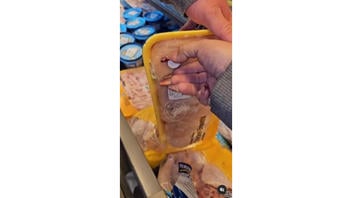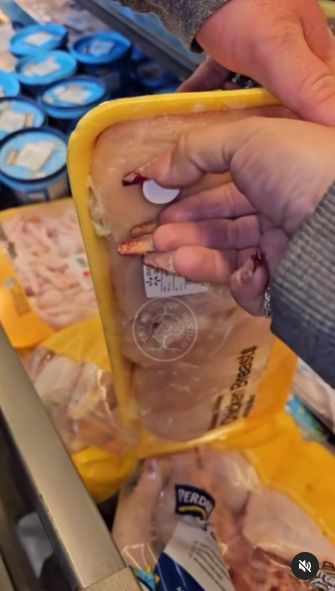
Does a video that shows what is said to be a magnet sticking to packaged supermarket chicken prove that such products contain nanotechnology and heavy metals? No, that's not true: The U.S. Department of Agriculture ensures that poultry products are safe and unadulterated, an agency spokesperson told Lead Stories. Magnets, they added, may stick to meat and poultry products due to the texture, angle or moisture of the product or its packaging -- but this does not provide proof of metal contaminants. A professor of horticulture science also confirmed to Lead Stories that "there are no iron nanoparticles used in poultry production."
A version of this claim was shared in a video posted to Instagram on June 29, 2024 (archived here), that appeared to show a magnet stuck to a package of chicken, presumably at a supermarket. A caption that accompanied the post read:
Beware 👁️ of the nano tech in your food. The new 6g will not be more gwen towers, it'll be people; full of heavy metals and nano particles binging off and receiving signals that can control your nervous system....
#emfprotection #emf #nanotechnology #smartdust #chemtrails #operationlockstep #5g #6g
Here is how the post appeared at the time of writing:
(Source: Instagram screenshot taken Mon July 1 05:09:00 UTC 2024)
The U.S. Department of Agriculture's (USDA) Food Safety and Inspection Service (FSIS) (archived here) ensures that "meat, poultry, and egg products are safe, wholesome, and unadulterated," an agency spokesperson told Lead Stories in an email received on July 3, 2024.
All FSIS-inspected establishments are required to have a Hazard Analysis and Critical Control Point (HACCP) (archived here) system in place, which is designed "to prevent, eliminate, or reduce to a safe level any biological, chemical, or physical hazard that is reasonably likely to occur in the product," the FSIS spokesperson wrote. Metal pieces, whether magnetic or not, are considered a physical hazard. For this reason, establishments must consider metal pieces in their hazard analysis, determine whether such contamination may occur in the production process and identify preventive measures to control any potential hazards.
Establishments are responsible for implementing these programs, wrote the spokesperson, adding that:
Many establishments install metal detectors and/or X-ray devices for screening their final products to ensure no accidental/unexpected metal (e.g., a broken equipment piece) is present in their final products. Establishment personnel calibrate and check such detection devices frequently throughout each day of production to ensure proper functionality. FSIS inspection personnel regularly verify all establishments production processes and intervention steps, including metal detection as applicable, to ensure proper implementation and follow up by the establishment personnel.
Kevin Folta (archived here), a professor of horticultural science at the University of Florida, also confirmed to Lead Stories that "there are no iron nanoparticles used in poultry production."
"Chickens have been bred to rapidly attain their weight and size -- just traditional breeding. There is no need to invest in antibiotics, hormones, or iron nanoparticles. They do just fine on their own," wrote Folta in an email received on July 2, 2024.
Although the female voice in the post refers to "a magnet I got from here," the post does not otherwise provide proof that the "magnet" is that or that either the magnet or the packaged chicken has not been tampered with. Folta added that the video does not show good control use because other plastic-wrapped products would similarly affect a magnet.
"The easy explanation is that the magnet is grabbing onto the plastic through basic adhesion, as the plastic wrap is made to stick to itself and other items," Folta said. "The other easy answer is that it is just a trick by a couple of people looking for clicks, and the little piece of tape creates the simple illusion."
FSIS echoed these sentiments, adding that magnets may stick to meat and poultry packaging due to the product's texture, angle or moisture.
According to FSIS, all meat and poultry products bearing the USDA mark of inspection have been inspected for safety, wholesomeness and proper labeling.
Other Lead Stories fact checks involving nanotechnology can be read here.













